Dogsleds
|
 If
a great computer tried to develop a better dogsled than the ones oldtimers
made, it would fail. Dogsleds are an engineering masterpiece. New
materials have opened up new possibilities, but the factors involved
are the same. If
a great computer tried to develop a better dogsled than the ones oldtimers
made, it would fail. Dogsleds are an engineering masterpiece. New
materials have opened up new possibilities, but the factors involved
are the same.
Dogs are available as an energy source in other parts of the world, but aren’t used because more powerful animals are available, like horses, donkeys, and oxen. Since those animals aren’t practical in the arctic, dogs were the best sou rce of power until the advent of the snowmachine. Each dog can get himself from point A to point B, but pulling a load greatly reduces the distance that each dog can go. Sled design and dog mushing has to be a science to maximize the limited energy available from a team of dogs. Dog mushing is a constant study in energy conservation. Snowmachines seem to have power to waste, but the same scientific principles that apply to dogsled design also apply to snowmachine sleds. |
||
Energy ConsiderationsThe dogs are pulling against several forces.
|
|||
Runners and FrictionHigh friction runners tire the dogs very rapidly. Of course, the bigger the load is, the higher the friction will be. |
|||
 |
Before PlasticBefore plastic we used hard steel runners in warm weather and wooden runners in cold weather. Steel runners were very good for spring travel, swimming creeks and crossing thawed lakes, but came to a halt on bare tundra. Megafriction! In the spring we traveled for miles and miles on tundra, trying to avoid bare ground, going from patches of snow to glaciered creeks back to patches of snow. The difference in friction between snow and tundra is tremendous! Steel runners were also very high friction in cold weather. They groaned like an old fishwheel. And woe unto the musher in cold weather who didn’t avoid fresh dog excrement on the trail. It froze to the steel runners and was the equivalent of setting an anchor. The hard ironwood runners used in cold weather were imported from the lower 48 then to Alaska. They were fairly low friction in very cold weather once they got a glaze on them. Some people used pine tar to make them run smoother, but it soon wore off. The oldtimers also knew that spruce trees that grow on hillsides have a streak of hardwood on the downhill side that forces the tree to grow straight up rather than straight out from the hillside (geotropism). That hardwood is also good for sled runners. Often we tipped our sled over in the morning and iced the runners with a rag and a can of warm water. There was speculation whether sugar made the icy film more durable. Long ago, urine was used, but it isn’t good for hunters and trappers who try to minimize the impact of their presence on the country. Changing Weather This is a part of the good old days we would just as soon forget. The only solution was to put wood runners over steel runners preparing for all types of weather. This worked, but made the sled heavier. We spent many hours changing runners as the weather changed. Very long ago, oldtimers used bone for runners. I understand that bone provided low friction, but was very difficult to attach to the sled. Modern Materials Today we have the choice of many plastics. While some are better than others for low friction and durability, plastic has low friction at all temperatures; it is strong, light, and dog excrement doesn’t adhere. It is easy to attach and fairly durable. (Be certain to put plastic on when it is warm. Plastics expand greatly when heated. If you put runners on cold, they will expand in warm temperatures, creating bulges that fill with snow.) Exposed mountain rocks destroy a pair of plastic runners quickly as the sharp rocks haven’t been smoothed and tumbled like river rocks. If the musher avoids exposed rocks, plastic lasts for a long time.
Plastic runners have more friction on the tundra than they do on snow, but they are a hundred times better than steel or wood! We have traveled many miles on bare ground with plastic runners and a considerable load with only a few dogs. Plastic runners are unaffected by water and give considerable strength to the sled’s frame as they are flexible and durable. |
||
|
|
Mountain TravelTraveling in the mountains can be dangerous. It is hard to climb hills and mountains with a dogsled. Dogs get discouraged, and are occasionally injured pulling on the hard-packed, windswept snow. Going down a mountain pass is another story, particularly if traveling on a sidehill. There are several techniques to use. The main thing is to:
Reducing Pulling Power Dogs are afraid of being run over by the sled on a steep hill or mountain.
Increase Friction
You could imagine what would happen if we put the roughlocked chain on the front of the sled. The inertia of the back end of the sled would cause it to pass the front, like jamming the front brake of a bicycle. The snow on the mountains isn’t consistent. There are places where it seems as hard as concrete from the wind, and places where it is soft. It is easy to run over the dogs or tip over and start tumbling. Sidehill If the trail involves going down the side of a mountain, it can be complicated. The sled will tend to slide sideways down the slope. When traveling on a sidehill, we put more roughlocking on the uphill side of the sled. As the dogs pull, the sled pulls unevenly, holding it on the sidehill angle. Once the sled gets out of control and starts tumbling down the mountain, tremendous injury and damage to your sled and dogs is likely. |
||
Rhythm The same principle works with dogs. If they can get and keep a rhythm, they can travel for many miles. If the sled is jerking, it throws them out of stride, causing them to tire quickly. Overcoming the inertia of the erratic sled is exhausting for them. The main job of the musher is to kick, push and steer in a way that the sled goes as smoothly as possible, without jerking, tugging, and breaking the dogs’ rhythm. An inexperienced musher kicking out of rhythm with the dogs can actually slow the sled. He thinks he is helping to propel the sled, adding his force to the dogs efforts, but he is being counter productive by breaking their rhythm. Mushers have noticed, like cross country skiers and runners, that their kick has far more power if they follow through on their kick backwards, even after their foot has left the ground. Action equals reaction. When the leg is forced quickly backward in the air, the opposite reaction is the sled going forward. Cross country coaches often instruct their runners, “kick, kick.” They are using the same science principle. |
|||
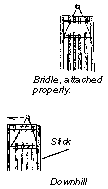 |
TurningTurning the sled takes energy from the dogs. This is why the musher usually puts his/her strongest dogs nearest to the sled. Once the sled gets off the trail, particularly with a big load, it takes considerable energy to get it back on. The most efficient way is to stay on the trail. It is important to rig and build the sled so that it steers well. Bridle If the bridle were attached in the middle of the sled, it wouldn’t have the leverage to steer as the sled weaves from side to side on the trail, or navigates trees in a portage. The secret is to have the bridle attached as near to the front as possible to facilitate steering, but have it back enough that the towline is pulling slightly upward. It is also very important to have the ring of the bridle perfectly centered. If it gets off center, even a little bit, the sled will always tend to pull to one side, tiring dogs and driver. Sidehill Secret When traveling on a sidehill, the sled tends to slide downhill, exhausting and frustrating the musher and dogs and complicating travel, especially with a load. Oldtimers overcame this by putting a stick in the loop of the bridle on the downhill side, thus shortening that side of the bridle. This caused uneven pulling from the downhill side of the bridle, helping it follow the dogs. When travel returned to flat ground, the stick was removed, and the centered bridle pulled straight again. Rocker One of the most important things in a longer sled (over eight feet) is having a little “rocker” in the runners. One-fourth to three-eights of an inch is all that’s necessary. If the runners are perfectly straight, or worse yet, high in the middle and low on the ends, it will be very hard to steer. It will always tend to go straight. If there is too much rocker, the sled will continually swing back and forth, requiring constant energy to steer. It will have no ability to head straight and stay that way. I have made both of these mistakes. The sled with too much rocker had a twelve-foot runner, and it was still hard to keep on the trail. The sled that had no rocker was a ten-foot nightmare that couldn’t follow the dogs around the slightest corner. |
||
Ninety Years AgoBefore the fishwheel made feeding larger dog teams possible, men often traveled with only two or three dogs. The men had to pull too. The backs of the sleds had no place for a person to stand. The individual took his place in harness in front of the sled, behind the dogs. From this position, steering was a problem so they bolted and lashed a long pole on the right side that could lever the sled onto the trail. Braking from that position was very difficult, as might be imagined. When the trail was good, the man rode a single or double ski in front of the sled instead of walking with snowshoes. It wasn’t until fairly recently that men rode on the back of the sled. The single ski was similar to today’s snowboard. Care was taken to wax or oil the wooden skis and snow board to reduce friction as much as possible. |
|||
 |
|
||
Moving a Big LoadNowadays most mushers run around with empty or nearly empty sleds. We used to load a whole bull moose or three caribou in a sled and make it home with four dogs. That involved science principles, particularly when the sled got stuck. Static friction, the friction of something not yet moving, is much greater than kinetic friction, the friction of something that is already moving. Once the inertia of the stationary sled has been overcome, and static friction has been replaced by kinetic friction, the dogs can keep a big load moving without much effort. Once the sled is stuck, either from bumping a tree or sliding off the trail, three things must be overcome:
All of this amounts to an energy drain on the dogs and driver. To get going after sliding off the trail with a big load, pull about a foot of slack in the towline and let go while yelling at the dogs. When they hit the end of that foot of slack, the force of their weight and startup speed jerks the sled, overcoming inertia and static friction. We had to be careful using this trick with the dogs. They can exert tremendous force, sometimes breaking snaps and towlines. That meant a long walk home as the dogs took off alone. This same principle is used today in snowmachines where there is a spring in the sled hitch. The force of the machine hitting the end of the spring jerks the sled loose. Without the six inch spring, the snowmachine would spin out before it overcame the inertia and friction of the sled. |
|||
|
|||
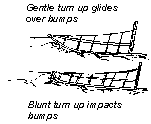 |
The BendA sled that has too abrupt a bend will constantly jerk the dogs backward. The forces from hitting a bump with a sled of this design are very negative. The amount of upturn and degree of bend depend on the country being traveled. |
||
Brakes We made brakes from iron similar to the ones today. Tools and materials were at a minimum, and brake manufacture was an art form. The problem is to have a brake that will work equally well on clear ice and soft snow. To stop on clear ice, sharp points must dig in at the proper angle. If the angle is too gradual, it will slide over the surface. If the angle is too sharp, it can hook logs and stumps, rip off the sled, and endanger the musher. Stopping on a hard packed trail is fairly easy, but fall time on clear ice, or traveling in the windswept mountains, the challenges are far greater. To stop in powder snow, there has to be enough surface area to provide the resistance to slow the sled. Some people now use pieces of cleated snowmachine tracks for a brake. |
|||
SummaryThere is no perfect sled. How you design a sled depends on your purpose and conditions. Every adjustment is a tradeoff. There is a limited amount of energy available from a dog team. That energy must be conserved as much as possible if the musher is going to haul a load or travel the distance. Sled design and operator skills make all the difference. With the same dogs and an efficient sled, a good musher can go two or three times farther than an inexperienced one. |
|||
 |
Activities
|
||
 |
Student Response
|
||
 |
Math
|
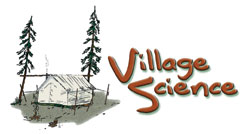
 Lacking
ironwood, many oldtimers split a green spruce tree in half, peeled
it, and used that for runners. The icy outside of the tree had very
low friction with the trail’s surface. However, the rounded
runners sank a little deeper in the trail than flat ones would.
The icy runners also dried out on cold nights, so we had to push
the sled into deep fresh snow to protect the runners from drying.
Lacking
ironwood, many oldtimers split a green spruce tree in half, peeled
it, and used that for runners. The icy outside of the tree had very
low friction with the trail’s surface. However, the rounded
runners sank a little deeper in the trail than flat ones would.
The icy runners also dried out on cold nights, so we had to push
the sled into deep fresh snow to protect the runners from drying.
 The
above wood runners worked well in cold weather, but woe unto the
musher who traveled far with wood runners and the weather turned
warm! Wood runners are very high friction in wet snow. Bolts, inset
one-half inch, hung down like a dozen thin brakes as the wood wore
away in the mild temperatures.
The
above wood runners worked well in cold weather, but woe unto the
musher who traveled far with wood runners and the weather turned
warm! Wood runners are very high friction in wet snow. Bolts, inset
one-half inch, hung down like a dozen thin brakes as the wood wore
away in the mild temperatures.

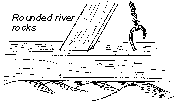


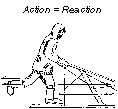 If
you were to jump around wildly, you would tire quickly. Overcoming
the inertia of the erratic movements would require much energy.
If you were to dance for hours, you wouldn’t get as tired because
the rhythmic motion is smooth, coordinated, and very energy efficient.
If
you were to jump around wildly, you would tire quickly. Overcoming
the inertia of the erratic movements would require much energy.
If you were to dance for hours, you wouldn’t get as tired because
the rhythmic motion is smooth, coordinated, and very energy efficient.
 Most
mushers today put a shock cord in the towline. This helps to absorb
some of the impact of the bumps and jerking of the sled. Maintaining
the dogs’ rhythm is the secret to endurance. Violating physics
principles results in tired dogs.
Most
mushers today put a shock cord in the towline. This helps to absorb
some of the impact of the bumps and jerking of the sled. Maintaining
the dogs’ rhythm is the secret to endurance. Violating physics
principles results in tired dogs.
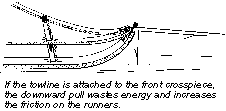 If
the bridle were attached to the very front of the sled, it would
steer easily, but some of the dog’s energy would be pulling
the sled downward, greatly increasing friction.
If
the bridle were attached to the very front of the sled, it would
steer easily, but some of the dog’s energy would be pulling
the sled downward, greatly increasing friction.
 Mule
skinners and farmers in the Lower 48 used the terms, “gee”
and “haw” in commanding their animals to go right or left.
They brought the terms to Alaska. The pole on the right side was
called a “gee pole.” From this we get the Alaskan term
“gee pole spruce.” They were the toughest trees to use
to lever the sled from side to side onto the trail.
Mule
skinners and farmers in the Lower 48 used the terms, “gee”
and “haw” in commanding their animals to go right or left.
They brought the terms to Alaska. The pole on the right side was
called a “gee pole.” From this we get the Alaskan term
“gee pole spruce.” They were the toughest trees to use
to lever the sled from side to side onto the trail.
 Loading
the Sled
Loading
the Sled Sled
Length
Sled
Length I
used to think of the brake as “negative dog feed”. The
chemical energy of dog feed converts to the energy of motion on
the trail. The motion and inertia of the moving sled must be preserved.
A brake is a friction devise to overcome that motion.
I
used to think of the brake as “negative dog feed”. The
chemical energy of dog feed converts to the energy of motion on
the trail. The motion and inertia of the moving sled must be preserved.
A brake is a friction devise to overcome that motion.